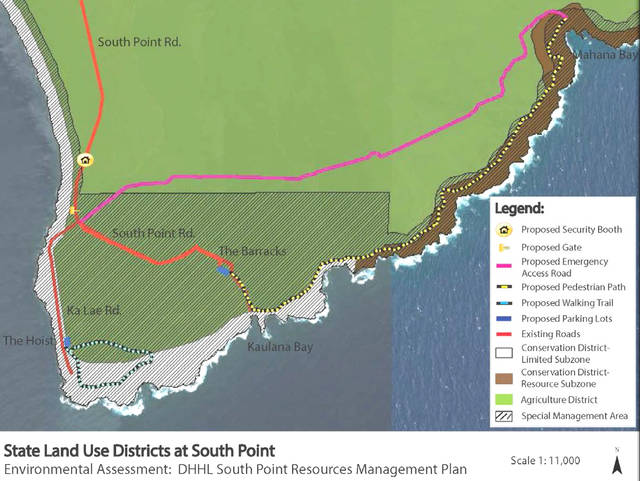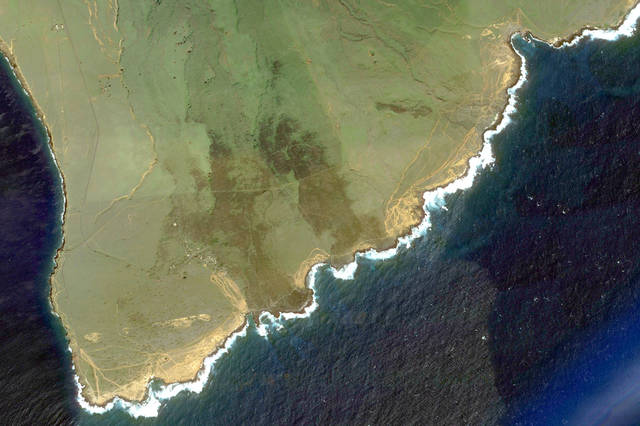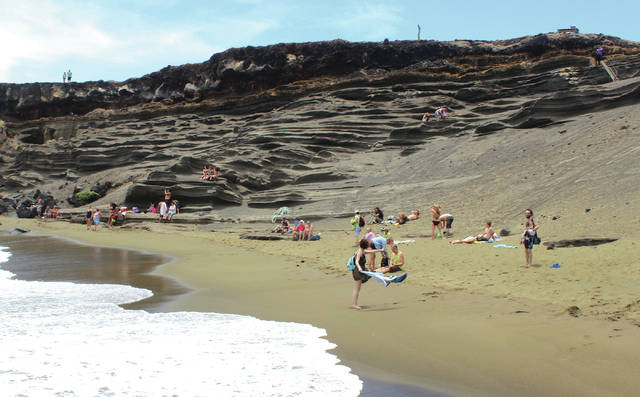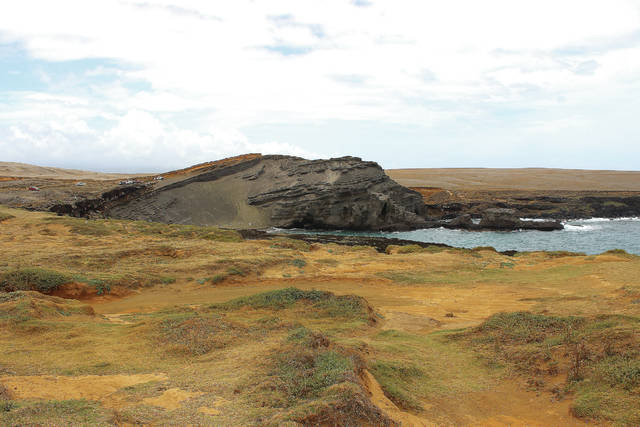State looking at better ways to manage Ka Lae

A parking fee and entrance gate on South Point Road are on the table as part of the state’s efforts to better manage resources at Ka Lae, also known as South Point, where the Department of Hawaiian Home Lands says resources are in “critical” condition. (DHHL South Point Resources Management Plan/Special to West Hawaii Today)



People enjoy the day at Papakolea Beach, a highlight of Ka Lae in Ka’u. (Chelsea Jensen/West Hawaii Today)

The heavy use of trucks, all-terrain vehicles and motor bikes has caused widespread sand and soil erosion.

KAILUA-KONA — A parking fee and entrance gate on South Point Road are on the table as part of the state’s efforts to better manage natural and cultural resources at Ka Lae, also known as South Point, where the Department of Hawaiian Home Lands says resources are in “critical condition.”
KAILUA-KONA — A parking fee and entrance gate on South Point Road are on the table as part of the state’s efforts to better manage natural and cultural resources at Ka Lae, also known as South Point, where the Department of Hawaiian Home Lands says resources are in “critical condition.”
The details of the South Point Resources Management Plan and its impact on Ka Lae’s resources are part of a draft environmental assessment released at the end of last month. The study determined the Department of Hawaiian Home Lands’ proposal would “restore, preserve and protect cultural and natural resources,” and generate revenue for the agency to support the area’s management.
The overarching effort is to get a better handle on ongoing “unregulated access” to DHHL lands at Ka Lae, which the document says has harmed both cultural sites and the coastal ecosystem. Specifically, the agency points at heavy use of trucks, all-terrain vehicles and motor bikes, which DHHL said have destroyed sites and caused widespread sand and soil erosion.
“Through the community planning and outreach process, DHHL worked with DHHL beneficiaries and Ka‘u community members to identify a collective vision for Ka Lae which is for the area to become a self-sustaining, healthy and safe community where the aina – inclusive of the people and resources within it — and native Hawaiian culture and values thrive,” said Department of Hawaiian Home Lands information and community relations officer Paula Aila. “DHHL hopes that the implementation of plan recommendations will lead to the realization of the community’s collective vision for Ka Lae.”
The agency’s Resources Management Plan outlines 16 individual projects — both short- and long-term — to manage the area and “let the land heal.”
“The main near-term priority for DHHL is to gain site control by managing vehicular access,” said the draft environmental assessment, saying doing anything else without first establishing an on-site presence “would be ineffective and a waste of financial resources and effort.”
The agency’s goals for the region range from restoring and preserving cultural and natural resources to generating revenue to fund management activities.
Each goal is accompanied with specific projects or strategies, such as the design and construction of a walking path to take visitors throughout the area and putting in place a parking fee.
Proposed actions also include an entrance gate at Kalae and South Point roads, a walking trail with signage, and a path from the barracks in the area to Papakolea or Green Sands Beach. An emergency access road is also proposed for the area.
During public meetings and talk-story sessions, area residents raised concerns that the area “has become a playground” for people who go off-road and “tear up the landscape,” and that unrestricted access has scarred the land.
The majority of the soils in the area covered by the plan are sandy loam soils, which are 50 percent sand and, when exposed, are highly erodible. Tradewinds frequently impact that area.
And while erosion already occurs naturally, unmanaged recreational vehicles in the area have cut deep grooves throughout the land and stripped vegetation that keeps the soil in place.
Combined with the natural wind erosion, the document states, coastal erosion has been exacerbated in the area.
Eroded soil also gets into coastal waters and degrades its quality, the assessment added, “a phenomenon that occurs frequently at South Point from the widespread use of recreational vehicles.”
The area also crosses three historic/archaeological districts, including the South Point Complex National Historic Landmark, Mahana Archaeological District and Kipuka Kuniau Archaeological District. All three locations are on the State Inventory of Historic Places.
The South Point Complex, the report states, includes the Kalalea Heiau, Kapapaloa Bay Village, canoe mooring holes and other resources that together form “a group of sites which provides the longest and most complete record of human occupation of the Hawaiian Islands.”
An associated cultural impact assessment raised some concerns about the effects of the plan, such as the potential for uncovering skeletal remains and limiting access for traditional and cultural practices.
In response, some community members quoted in the report suggested steps for mitigation, such as ceasing work in the event cultural or burial sites are uncovered and ensuring the proposed entrance gate doesn’t limit Native Hawaiians’ traditional and customary practices, noting that the area is “one of the most important fishing grounds in the Ka‘u District.”
One recommendation was that if an entrance fee for South Point be implemented, the fee be waived for Ka‘u residents.
One issue that would need to be resolved is that of wastewater treatment and disposal.
Currently, there are two portable toilets near the boat hoist, which are serviced by a nonprofit group.
But the state’s Department of Health has said a portable toilet doesn’t comply with state law and wouldn’t be approved for use.
While a preferred alternative hadn’t been identified at the time the report was prepared, compost toilets, septic tanks and a small treatment plant were all included as options, although each option presents its own particular hurdles.
The assessment did present some alternatives to the overall plan to manage the area, one of which being taking no action at all. The document though said that was “not an option,” saying the widespread destruction “is at a critical point.”
Another alternative was to close the DHHL-owned portion of South Point Road and prohibit vehicles from entering entirely.
While that strategy would be financially cheaper than the management plan and significantly reduce the impact of people, it would also eliminate any economic opportunities to use the area’s resources to support the agency’s beneficiaries.
Aila said the final environmental assessment and finding of no significant impact is expected around this summer. An implementation timeline will depend on sufficient funding being provided to DHHL.
The full draft environmental assessment is available online. The PDF version can be found at this link.



DHHL = lock up everything in sight – the Department of Kapu signs – it has gone nuts in the last 20 years . Now they want to lock down South Point ? Are you kidding ?
Only the government can take a free natural resource, fence it off, then charge for it and manage to loose money in the operation. More fees, more taxes that is what this is. When will enough be enough?
put strong winches on your vehicles
I notice a local statist is all for yet another big government land grab, so only “approved” sorts of people are allowed in to see what is theirs to begin with.
The atv and dirt bike crowd have no respect for the environment. They are not satisfied with the areas that have been designated for their use. DLNR has cited them on Mauna Kea so DHHL can find a way to remove them from Ka Lae without punishing every one else.
A gate with a small (voluntary) fee would be sufficient. A rest stop with a toilet, rain & wind shelter, water fountain and info poster would make tourists stop. Most of them would gladly pay.
Enforcement to prevent ATV and off road trucks is easily done with drones. Confiscation of a few of the used vehicles would put an end to it immediately. If it continues as it happens now, the landscape will be barren in a decade.
DHHL does not have the “police power” that DLNR has to confiscate property. DHHL has to call HPD and HPD is reluctant to get involved unless they are forced to. This is why I mentioned that DHHL has to find a (legal) way to accomplish this.
Interesting Idea, should be free to all Islanders. And of all the names on this here WHT BLOG “OLD MAN” is my now favorite. Thanks
I thought part of our Hawaii life is there is no blocking public access to beaches? What next? Do other beaches start charging for access and parking. This constant barrage of Government overreaching has to stop! Who are these people Nazis?
Who are these people Nazis?
They post here on the WHT liberal opinion pages all the time.
Exactly. I don’t see people driving vehicles on public beaches and getting away with it. However, certain parks and beaches are not open 24 hours a day. Hapuna does have parking fees for non-residents. DHHL will be critisized no matter what they do.
That’s because DHHL sucks. Make the 4WD rentals 3x more expensive than regular cars again. Problem largely solved. All of these stupid cheap jeeps are ruining Waipio, Ka Lae, the summits, Makalawena, etc
Take a look at the names on the DHHL leadership page . All Hawaiians right? Not…
Hawaii’s nazis are the totally entrenched Democrat Japanee bureaucracy
Perhaps I was misunderstood….its Nazi like behavior.
Unlike today’s demography, Hawaii’s old demography respected our cultural resources. with minimal government management and regulation. Today’s anarchistic exploitation from external and local forces, governmental regulation and management have become necessary.
That is the crux of the issue, right there. Well said, mahalo.
well said and sadly true
I guess Harry can’t fit a Big yellow gate into his 500 million dollar budget. So he will have the people pay for it. Go Harry!!!!
as much as I hate gov interference…sadly it is needed…people are destroying the area…both Hawaiians and visitors(don’t get pissed at me for saying this)..a fee is fine,provide some infrastructure and a park ranger…keep it nice,clean..preserve…is this so bad????? alternative???..lockout for all
Yea but then where do they do it next? Pretty soon the fees will be so high at every beach no one will be able to go? Will the Resorts that have parking spaces allotted now b able to charge.
“overarching”
Finally, an contributor that uses his text tools.
Perhaps, just perhaps enforcing the EXISTING rules on this powerful piece of our island would be a good start. We were there yesterday and the number of idiots jumping from the cliff was crazy, so was the number of rental Jeeps driving to Papakolea and trucks driving in tourists not wanting to take the hike. So much mana in a place being loved to death.
I say restrict Ka Lae to permits, like Honomalino. Implement and enforce rules and laws. I don’t want this significant site to the Hawaiian culture desecrated.